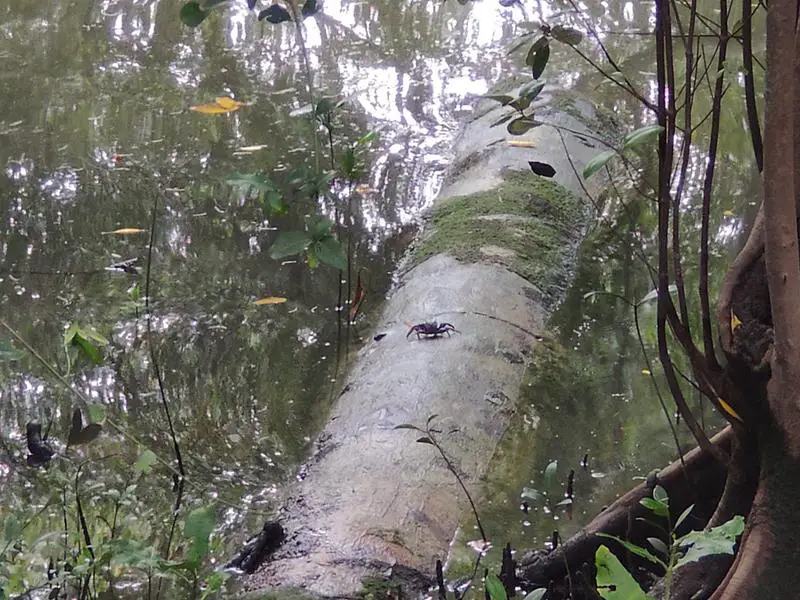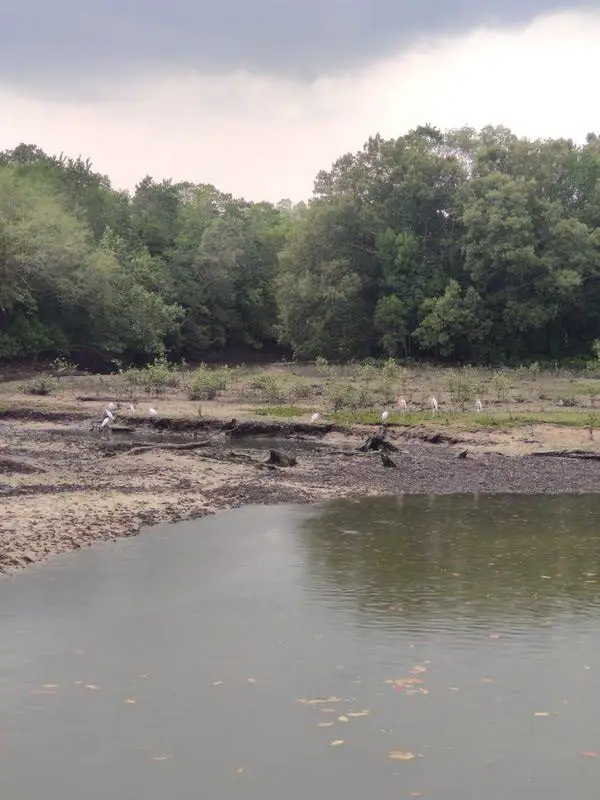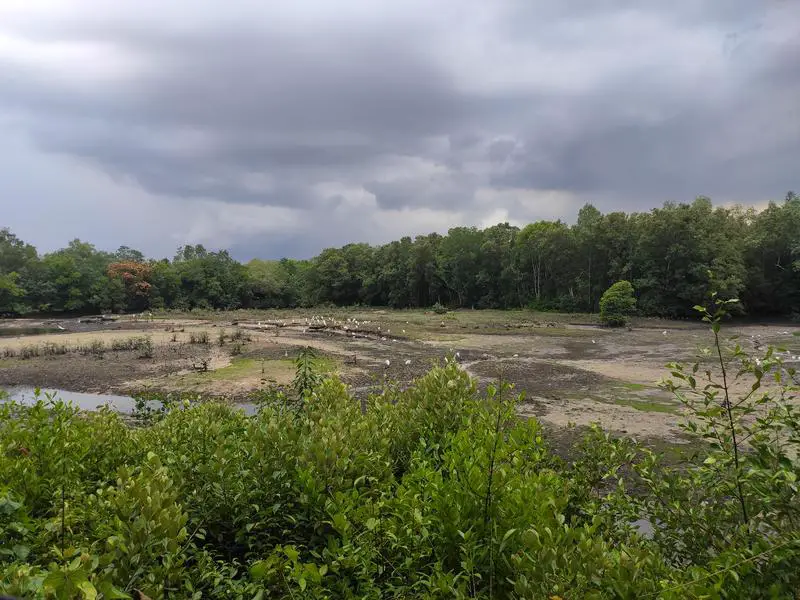Looking for an easy walk in nature with lots of wildlife spotting opportunities? Sungei Buloh Wetland Reserve is probably one of the best places in Singapore for the job. For a place teeming with local and migratory wildlife in a range of natural habitats, Sungei Buloh has got to be one of the most accessible and inexpensive options.
Jan 2022 Update: A major section of the Coastal Trail is currently closed and and scheduled to reopen in March 2022. More information here.
While there are ongoing works to expand the nature reserve, Sungei Buloh Wetland Reserve currently consists of 2 main sections, the mangrove forest, which the Coastal Trail weaves through, and the wetlands, where the Migratory Birds Trail makes a loop around. Various species of birds stop by at different times of the year, so there is usually something new to look out for on each trip here. Regardless of when you decide to visit, here are some of the sights you might expect from a comfortable walk on the 2 trails (roughly 3-4km).
Getting to Sungei Buloh Wetland Reserve
Public Transport
The closest MRT station to Sungei Buloh Wetland Reserve is Kranji MRT Station. From Kranji MRT Station, take bus 925 and alight at Kranji Reservoir Park B, the stop in the carpark right after Kranji Dam. It’s a short bus ride through some industrial estates. From the carpark, cross the road (Kranji Way) and head straight in to Sungei Buloh Wetland Reserve, and in a few minutes you’ll be at the Sungei Buloh Wetland Reserve Visitor Centre.
Alternatively, if you’re making the trip on a Sunday or on a public holiday, 925M will be plying this route instead. You can still board the bus at Kranji MRT Station. However, after Kranji Dam, the bus does not turn into Kranji Reservoir Park B, but instead stops at the bus stop just after Kranji Reservoir Park B. Either way, if you’re heading to the Kranji Way entrance for the Coastal Trail, alight right after Kranji Dam. If you’re heading for the Migratory Birds Trail, 925M will take you closer to the start of the trail at Sungei Buloh Wetland Reserve Wetland Centre (different end of the park from the visitor centre). The wetland centre stop is 4 stops after Kranji Dam. Do note that on other days, only bus 925 operates and the Kranji Reservoir Park B stop is the closest to any end of the wetland reserve.
Shuttle Service
There seems to also be a free shuttle service that plies Kranji MRT, the visitor centre, the wetland centre and Kranji Marshes, and runs only on weekends and public holidays. The bus may not be sufficiently sized for the crowd so do plan for backups. During my trip there, when we were trying to get out of the wetland centre, 2 buses arrived full and unable to accept more passenger so we walked a long way in the rain back to the Kranji Reservoir Park B bus stop for bus 925. More information on the free shuttle bus may be found here.
Kranji Way Entrance and the Visitor Center
At the Sungei Buloh Wetland Reserve Visitor Centre, there is a gallery which makes a great introduction to the mangrove forests you’ll be entering soon. Nothing too fancy, but pretty informative. Here’s also the last spot to get a toilet break, light snacks or drinks, for the next hour or so. We were admiring a funkily shaped fruit on a tree along the way when a friendly guy approached and gave us an introduction to it. According to him, the tree is known as the sea poison. The fruit is poisonous to fishes but has medicinal uses for humans. Traditionally these fruit were used to lure fishes near to shore, where the fishes would feed on the fruit and get knocked out. All that would then be left would be to pick the lifeless fishes out of the water. Neat.

The Coastal Trail (1300m)
2 trails start from the visitor center, the Forest Trail and the Coastal Trail. The Coastal Trail keeps to the right and leads to a path along the Straits of Johor. Just a short way from the start of the trail, there is a boardwalk that’ll offer a different view of the mangrove forest, looking seaward in. Eagle Point, a viewing platform on the sea, is also on this boardwalk. As the boardwalk closes in to the shore again, the well marked path takes you right into the mangrove forest. Do stay on the demarcated path and look out for animals crossing, as the creatures big and small may get startled by unexpected movements and injuries may occur.



Mudskippers and Horseshoe Crabs
From the entrance to the mangrove forest you would likely have spotted birds or other wildlife that are less commonly spotted in the densely built up areas in Singapore. We spotted a water hen, but then again they seem to be an increasingly common occurrence near water bodies even in urban environments. If they’ve all eluded you thus far, fret not, as many creatures await in the mangrove forest. Two common animals you’d likely come across in the shallow muddy ponds of the mangrove forest in Sungei Buloh are mudskippers and horseshoe crabs. Both are pretty cool animals, the mudskipper being a fish that can live out of water, and the horseshoe crab being an animal that has been around for 400 million years yet undergoing minimal evolution.





Other common critters
Other animals that are almost likely to be seen at the mangrove forest include huge spiders, crabs, monitor lizards, and slightly larger lizards.


It was an interesting opportunity to get inside a mangrove forest while on a mud-free and safe path. The scene changes with the tide, and the animals are almost always out and about, not minding much about the nosy humans.




Kingfisher Pod and Mudskipper Pod
Further down the Coastal Trail, there is again another boardwalk that leads just a little towards the sea, then inward along one of the waterways of the mangrove forest. The Kingfisher Pod and Mudskipper Pod are along this boardwalk. The pods are uniquely designed to allow observation of the nearby wildlife under some camouflage so as to not disturb the wildlife. This boardwalk also weaves through the deeper waters of the mangrove forest and allows for a close up look of the trees.







Sungei Buloh Wetland Reserve Wetland Center
The boardwalk then rejoins the Coastal Trail and reaches the Plaza, where there’s the other entrance to Sungei Buloh Wetland Reserve, along Neo Tiew Crescent, as well as the other visitor centre, the Sungei Buloh Reserve Wetland Centre. But first, some of the beautiful trees at the Plaza.




The Wetland Centre has toilet facilities as well as simple vending machines to get a quick refreshment. There are also information boards here that are more related to the wetlands, the next part of Sungei Buloh Wetland Reserve. From the wetland centre, there used to be a bridge over to the wetlands. However that is now closed and the new bridge is just slightly further away, towards the Mangrove Boardwalk.
Migratory Birds Trail (1950m)
Take the new bridge to cross Sungei Buloh Besar, and you’ll be transported to quite a different habitat. Here, you’ll still find native wildlife but it’s the visiting birds from around the world that steal the show. The path goes on a loop around the wetland, with foliage forming a natural barrier between the path and the wetlands. Along the way, well-spaced observation huts allow for a closer look without disturbing the birds. While the path is well covered by foliage, the wetland itself is pretty open. Migratory bids stop by this expanse for a rest and to feast on the critters that reside in the streams and shallow ponds.




Platform 1
Looks like there’s plenty to eat around here, as we spotted a chonky looking monitor lizard stomping through the undergrowth. Moving about much more nimbly was a water hen, also quite commonly seen in nature reserves in Singapore. While some monitor lizards shy away from the noisy paths, some seem to bask in the attention, like the one below that sauntered along the path, either oblivious or in enjoyment of the shutters going off all around.




And on to the birds! It was breathtaking. There were huge flocks of birds in different shades and shapes, and even at a distance it was possible to tell that these were big birds. Not huge like vultures but definitely larger than the city birds. These pictures don’t quite do the spectacle justice, you’ve got to witness the incredible sight in person. I’ve got work cut out in identifying birds, but even without any bird identification knowledge the view was spellbinding. What makes this even more amazing is that these are wild birds in a natural habitat.



At every opening along the path, the view changes ever so slightly, while still circling around the same open field.


Sungei Buloh Wetland Reserve Hide 1C
Some of the bird observation hides also provide information on the birds you may spot on the wetland. This particular one (1C I think) provides a close up of the wetland, and it is possible to see the smaller, non-bird residents of this unique habitat. Mudskippers and clams can be seen here. In such a biologically diverse habitat, there’s bound to be lots going on at any time. In one instance, we saw a bird going after a snake that was going after a mudskipper. Somehow, all got away but it was an interesting chase to observe for a bit.





Aerie Hide
There is also an observation tower for a bird’s eye view of the particular wetland that the Migratory Birds Trail goes around. It felt a little strange that from this spot in Singapore, all the densely built up area that can be seen is not Singapore, but Johor. Also really amazing to think that just beyond the busy city center (Singapore or Johor likewise), such an ecologically diverse place can thrive. Watching the rain rolling in on a cloud from Johor was just another stunning sight we caught that day.



Sungei Buloh Wetland Reserve Hide 1E
It started pouring by the time we got down the observation tower. Being an outdoors place, the only shelters available were the observation hides so they got crowded when the rain arrived. Good time to enjoy a different view of the wetland.




When the rain lightened slightly we took our chance to get back to the wetland centre. It was a long way in the rain. As some parts of the trail were exposed, it would be difficult to keep dry even with an umbrella. All in good fun.
A final encounter at Sungei Buloh Wetland Reserve
Just as I thought we were done for the day, there was one more surprise waiting. I had been hoping to see the famed crocodiles on this trip but despite keeping a close lookout, they remained elusive thus far. Finally, while on the bridge back to the wetland centre, an oddly shaped log floating on the river caught my attention. A closer look confirmed it was what I had been looking for. The exposed bridge wasn’t exactly the best place to stop in the rain, but my excitement knew better. I struggled to get a shot of the croc, which was quite a distance away but unmistakably the elusive beast. Fortunately or not it didn’t move much, but my trip to Sungei Buloh Wetland Reserve now felt complete.



Wet in the wetland
We tried to get on the shuttle bus to Kranji from the wetland centre, but 2 buses that came were full and unable to take more passengers. Being slightly cold, wet and hungry, we decided to walk out on the road along the farms to the Kranji Reservoir Carpark B bus stop to catch the more reliable public bus to get back to civilisation. There seemed to be some interesting farms in the area to explore but it was enough adventure for a day. Pretty awesome day out!
For more hiking ideas in Singapore, check out this post!

![[Australia] Tasmania Road Trip Part 4 - West to South Horseshoe Falls, Tasmania.](https://aaronteoh.com/wp-content/uploads/2023/12/DSC03977-1200x800-1-150x150.webp)
![[Singapore] 12 Hiking Trails to Check Out Central Catchment Nature Reserve, Singapore.](https://aaronteoh.com/wp-content/uploads/2021/07/2-DSC00028-800x533-PIL-150x150.jpg)
![[Singapore] Cross Island Day Hike from Gardens by the Bay to Woodlands Waterfront - The Wrong Coast to Coast Trail cross-singapoe-hike-800×500-PIL](https://aaronteoh.com/wp-content/uploads/2021/08/cross-singapoe-hike-800x500-PIL-150x150.jpg)